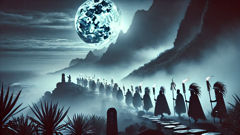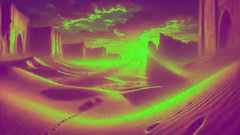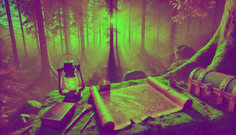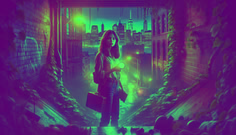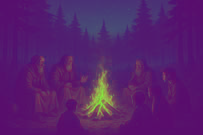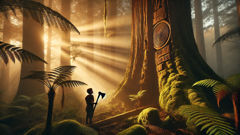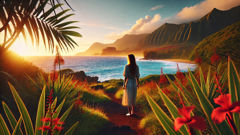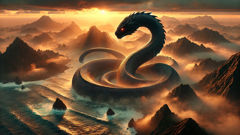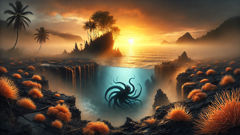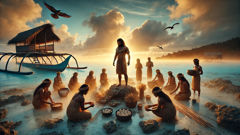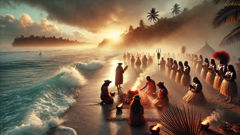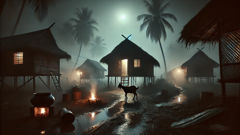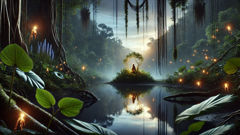Introduction
The first time you hear the story of the Night Marchers, it comes like a low drum across water: a rhythm you feel more in your chest than in your ears. Even people who were raised on the islands and can name every pōhaku and ridge will pause when the name is spoken, as if the syllables themselves call a careful silence. At dusk, when the heat loosened and the sky turned a deep coastal indigo, elders used to tell children not to run after the gulls or to chase bright fireflies. They would say, simply: remember the paths. Remember the kapu. The Night Marchers—Huaka‘i Pō or Ka‘eke‘e o ka Po—are said to move along the old boundaries, through valleys and along ridgelines, across the same routes their chiefs walked in life. On certain nights the veil thins. The air seems to hold its breath. Dogs lift their heads and go quiet. People who have lived long on the islands speak of a cold that comes without wind and the distant sound of pahu—drums—beating as if kept by invisible hands. Those drums mark a procession: rows of warriors in feathered lei and mahiole helmets, spears and short clubs reflecting moonlight like teeth. They do not hurry. They do not stop to look at the living. They pass with the slow, terrible dignity of things that still remember orders given centuries ago. There are strict instructions passed down by kupuna and kahuna: do not cross their path; lie face down if their eyes fall on you; give them the space of kapu. In many versions of the tale, these are more than ghosts. They are ancestral guardians and the restless spirits of chiefs who maintain sacred boundaries. In others, they are warnings—manifestations of ancient laws that must not be broken. The story shifts depending on who tells it, the moon phase, the valley you stand in, but the spine of the warning remains: to look at them is to risk more than a fright. Even now, in a world of bright screens and tourist beaches, the legend holds an urgent, living lesson about reverence, place, and the lines that bind the past to the present.
Origins, Orders, and the Shape of a Procession
The Night Marchers are not a single tale with a neat beginning; they're a braided history of memory, religion, and the geography of islands. To understand them, you have to imagine Hawai‘i not as a postcard but as a patchwork of mana—places of concentrated spiritual power—and kapu, the rules that held those places together. Chiefs—ali‘i—kept rank and route. They walked with attendants, with kahuna who tended the gods, and with men who carried the standards of lineage. When a chief died, his path remained consecrated. Over generations those roads—trailways between fishponds and heiau, through lava beds and along the spine of a mountain—kept their sacredness. The Night Marchers are said to be the processions of those once-living ranks: ancestors who continue to walk, whether out of duty, anger, or a refusal to let the boundary be forgotten.
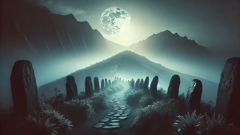
Scholars, kupuna, and storytellers describe many rules about encountering them. Some versions insist the marchers come only on nights of certain moons or on anniversaries of significant battles. Others expand the calendar: any night a kapu has been broken, when a grave is desecrated, or when the ancestor's name has been misused, the procession may swell. The visual details are specific and startling. Witnesses report pillars of light where torches might have been, or the suggestion of torchlight without flames. They hear the peculiar cadence of distant drumming and the soft, ritualized chant of a hundred voices, a heritage rolled slow like tide. The warriors' helmets, mahiole fashioned of feathers, appear as dark crowns. Lei of feathers and shells tremble as if with a wind that does not touch the living. Spears and clubs—koa and ulīulī—gleam with faint, otherworldly highlights. Sometimes chiefs ride in palanquins, their faces serene and terrifying in equal measure.
What keeps this story from being mere ghost theater is its grounding in place. The marchers are associated with particular wahi kapu—sacred sites—and families that are caretakers of certain stories. On Maui, people point to old trails along the leeward cliffs. On O‘ahu, there are valleys whose ridgelines are said to be the nightly passageway of a great chief’s retinue. The routes matter because they align with cultural memory: the marchers do not wander randomly. They repeat the steps of history. That repetition transforms the story into an instruction manual for behavior: do not plant where the ancestors walked; do not hunt at night where a heiau stands unhonored; do not build without asking permission of the land's caretakers. Many versions add physical consequences. To look a marcher in the eye is to be invited into their gaze—an exchange that might pull the living into the procession, or curse them with misfortune. The seriousness of the warning is underlined by recurring prescriptions: dishonor them and you might not die immediately, but you'll live with a string of small collapses—houses that leak at inexplicable seams, crops that fail, children who fall ill—that remind your family to remember.
The ceremonial tone of the legend also carries the rhythms of Hawaiian belief. Many nights, kahuna would advise to leave offerings at boundary stones, to chant a pule (prayer) asking for safe passage, or to perform a small ritual of acknowledgement. This marks a deep ethical thread: the Night Marchers are not malevolent beings in the simplistic sense. They enforce a kind of spiritual law. They are guardians of lineage, and they demand the recognition owed to those who shaped the landscape. The storyteller—whether elder under a pandanus awning or a modern scholar speaking at a cultural center—often emphasizes humility. When you meet the past, you must lower your head. In several versions of the tale, the one who lies face down while the marchers pass is spared a callous notice or theft of life; in another, the marcher will place a feathered lei on a prostrate head as a sign of acceptance and protection. That ambivalence—fear braided with reverence—makes the story endure.
Even skeptics concede that the story functions as cultural infrastructure. It binds people to memory. It teaches children that some paths are older than their games and that the land remembers. The Night Marchers, then, are both narrative and law: a way to encode respect. Yet they also remain a theater of the uncanny. Testimonies vary and sometimes conflict: one witness insists the marchers are bright with torchlight and shout like wind; another insists they have no sound at all, simply a pressure you can taste on your tongue. But the central, immutable advice repeats in every telling: if you are caught where they pass, lie face down, do not look, do not whistle, and give them their space. Even in a modern island life with asphalt and LED bulbs, families will teach the same gestures, because some advice is stubbornly useful. It protects both the living and the fragile web of memory that keeps iwi and places accounted for. Stories about the Night Marchers are not merely entertainment; they are prayers disguised as cautionary tales, and in that disguise they have survived centuries.
Encounters, Warnings, and the Living Memory
Stories of encounters with the Night Marchers are the threads that make the legend tangible. An elder on Kaua‘i remembered, late in life, how his grandmother told him that when she was small the family had to stop a wedding because the procession would walk the ridge where they planned to hold the celebration. The kahuna at the time refused to move the wedding just to please curiosity; they rescheduled. In the tale the family attributed a later harvest to that decision, though the line between gratitude and post hoc ritual thinking is thin. Another story, repeated around quiet pub tables and in cultural programs, describes a fisherman on O‘ahu who woke to the sound of drums. He stepped outside to look and found himself staring into a column of perfect darkness where torches would have been. He did not whistle. He lay down in the yard with his face to the earth until the sound passed overhead like a slow wind. When he rose, there were prints in the dust where no feet touched and a single feather on his chest as if a marcher had noticed and given him a blessing or a warning.
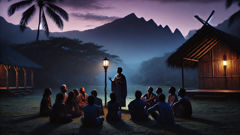
There are darker variations, too. A popular version tells of tourists who laugh and take filmed mockeries of ritual at night, ignoring an old woman’s warning. Their car stalled on a ridge as a procession filled the road. They tried to move through—some out of impatience, some out of fear—and their headlights dimmed. The wind turned a wrong direction. A few months later the party scattered; one returned home with a persistent, inexplicable illness. Whether true or cautionary fiction, such stories circulate as practical warnings: the islands are still a place with living elders, and cultural boundaries should be honored.
That tension between tourists and cultural custodians has only grown as Hawai‘i becomes a global destination. Land-use battles, the commodification of kapu sites, and the commercialization of sacred stories have provoked resistance. Kupuna, cultural practitioners, and some community groups have asserted the critical point: the Night Marchers legend is not a marketing device or a roadside scare for thrill-seekers. It is a teaching. In the hands of elders, the story returns to its function as social glue. A kahuna might tell the tale to younger people as part of an education about genealogy and place. A community preservation group might include reference to the Night Marchers when petitioning to protect a ridge or sacred pond, because the story marks a site as culturally significant. In courtrooms and at planning meetings, oral histories about ancestral routes are now used to argue for protection of wahi kapu. That legal turn is a reminder that stories move beyond campfire talk; they have material consequences in zoning, in conservation, and in the rhythms of development.
The modern encounters with the Night Marchers often hinge on technology and humility. Cell phone lights can be intrusive on a night a procession is said to pass; many kupuna advise to keep devices stowed and to lower one's head. Contemporary accounts sometimes add a practical detail: if you are driving and the procession is on the road, stop the car at a safe distance, turn off headlights, and wait with engine off and doors locked until the sound passes. In families where the story is alive, parents will tell children not to mimic a chant for attention or to post a provocation online. These are small protocols that echo the older rules but apply them to new circumstances. The legend adapts not by losing its core but by translating it into modern language: respect now includes not sharing ritualized mockeries on social platforms.
Cultural practitioners emphasize that the Night Marchers are part of a living cosmology. They aren’t merely spooky. They are also teachers of balance. The same procession that can take a life in stories can also bestow protection in others: a prostrate person who shows proper humility might be touched by a feather and later find a door opens or an illness recedes. The exchange implies reciprocity. In a world that often prizes exploitation, the Night Marchers ask for restraint. One kupuna told a student activist, quietly: to live on this land is to carry its memory. That charge is the real import of the legend: it shapes how a community thinks about belonging and stewardship. The ghosts are less a plot device than a continuing conversation between generations.
Finally, the legend's endurance testifies to its elasticity. As islands change—roads widen, resorts bloom, and old heiau stones hide beneath modern foundations—the story expands to include new warnings about forgetting. People still report the drums, still advise to lie face down, still pass the instruction to children. The Night Marchers, in that sense, do more than haunt the night; they haunt the forgetting. Their procession is a challenge: remember your routes, your names, the kapu; honor the old orders; do not steal what is not yours. When communities heed the story, they preserve the living landscape. When they ignore it, the tale warns, the marchers will step into the gap and remind the living of what was lost. That promise—of protective blessing or corrective force—keeps the legend as relevant today as when carved petroglyphs first marked a path.
Conclusion
The legend of the Night Marchers endures because it works on many levels at once: as a haunted spectacle, as a moral lesson about humility, as an ecological and cultural boundary marker, and as a living practice that shapes how communities steward land and memory. Whether you tell the story to children to keep them from wandering after dark or use it as part of a formal oral history in a conservation case, the warning is consistent: the past calls to be acknowledged. The rites surrounding the procession—lying flat, giving space, making a small offering—are acts of ongoing reciprocity between the living and the remembered. In a world that asks for quick answers, the Night Marchers demand patience; in a world that often values conquest, they insist on regard. They remind us there are roads older than our maps and laws older than our ordinances. Most importantly, they keep alive a question rather than offering closure: when the veil grows thin, will we stand and watch, or will we kneel and listen? The answer shapes more than night; it shapes the kind of people a place raises, the continuity of names and songs, and the measure of our respect for the long lines that connect us to those who walked before.

